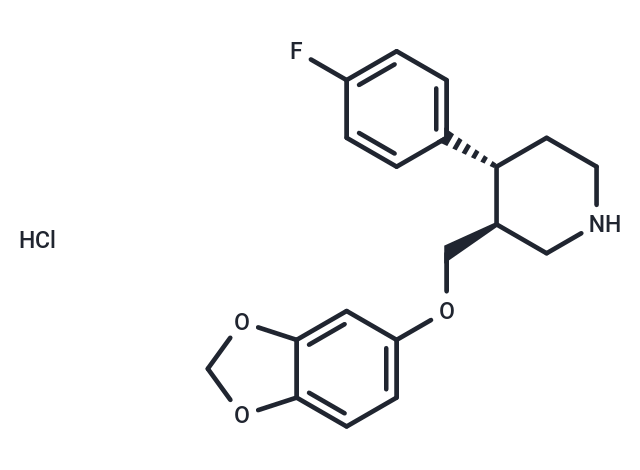Shopping Cart
- Remove All
 Your shopping cart is currently empty
Your shopping cart is currently empty

Paroxetine hydrochloride (Paroxetine HCl) is a serotonin uptake inhibitor that is effective in the treatment of depression.

| Pack Size | Price | Availability | Quantity |
|---|---|---|---|
| 25 mg | $45 | In Stock | |
| 50 mg | $54 | In Stock | |
| 100 mg | $78 | In Stock | |
| 200 mg | $112 | In Stock | |
| 500 mg | $153 | In Stock | |
| 1 mL x 10 mM (in DMSO) | $50 | In Stock |
| Description | Paroxetine hydrochloride (Paroxetine HCl) is a serotonin uptake inhibitor that is effective in the treatment of depression. |
| Targets&IC50 | GRK2:14 μM |
| In vitro | Paroxetine, at an ED50 of 1-3 mg/kg when administered orally (PO), demonstrates the capability to prevent the depletion of serotonin (5-HT) in rats' brains induced by p-chloroamphetamine (PCA), signifying an inhibition of serotonin uptake in vivo. Additionally, in isolated rat hypothalamic synaptosomes, paroxetine exhibits a dose-dependent inhibition of [3H] - 5-HT uptake with an ED50 of 1.9 mg/kg, while showing minimal effects on the uptake of [3H] - norepinephrine (NA), with an ED50 exceeding 30 mg/kg. |
| In vivo | Paroxetine, a highly effective hydroxylated metabolite inhibitor of (dextromethorphan), demonstrates the concentration-dependent reduction in the firing rate of serotonergic neurons within the DRN of super fused brainstem slices at 1-300 μM, with an IC50 value of 1.4 μM. With an inhibition constant (Ki) of 2 mM, Paroxetine's inhibitory capacity surpasses that of fluoxetine or norfluoxetine, indicating its more potent effect. Moreover, in rat cortical and in vitro hypothalamic synapses, Paroxetine acts as a potent and specific inhibitor of [3H]-5-hydroxytryptamine (5-HT), with a Ki of 1.1 nM. Its antidepressant activity is attributed to the increased concentration of 5-HT in the extracellular compartment, thereby enhancing serotonergic neurotransmission. Paroxetine also inactivates CYP2D6 by forming metabolic intermediate complexes. |
| Cell Research | Paroxetine is dissolved in DMSO. Cell viability is determined by the tetrazolium salt 3-[4,5-dimethylthiazol-2-yl]-2,5-diphenyltetrazolium bromide (MTT) assay. BV2 and primary microglial cells are initially seeded into 96-well plates at a density of 1×104 cells/well and 5×104 cells/well, respectively. Following treatment, MTT (5 mg/mL in PBS) is added to each well and incubated at 37°C for four hours. The resulting formazan crystals are dissolved in dimethylsulfoxide (DMSO). The optical density is measured at 570 nm, and results are expressed as a percentage of surviving cells compared with the control. |
| Alias | Paroxetine HCl, FG-7051, BRL29060A, BRL29060 hydrochloride |
| Molecular Weight | 365.826 |
| Formula | C19H21ClFNO3 |
| Cas No. | 78246-49-8 |
| Smiles | Cl.Fc1ccc(cc1)[C@@H]1CCNC[C@H]1COc1ccc2OCOc2c1 |
| Relative Density. | 1.213 g/cm3 |
| Storage | Powder: -20°C for 3 years | In solvent: -80°C for 1 year | Shipping with blue ice. | |||||||||||||||||||||||||||||||||||||||||||||
| Solubility Information | H2O: 10 mg/mL (27.34 mM), Sonication is recommended. Ethanol: 35 mg/mL (95.67 mM), Sonication is recommended. DMSO: 45 mg/mL (123.01 mM), Sonication is recommended. | |||||||||||||||||||||||||||||||||||||||||||||
Solution Preparation Table | ||||||||||||||||||||||||||||||||||||||||||||||
H2O/Ethanol/DMSO
Ethanol/DMSO
DMSO
| ||||||||||||||||||||||||||||||||||||||||||||||

Copyright © 2015-2025 TargetMol Chemicals Inc. All Rights Reserved.